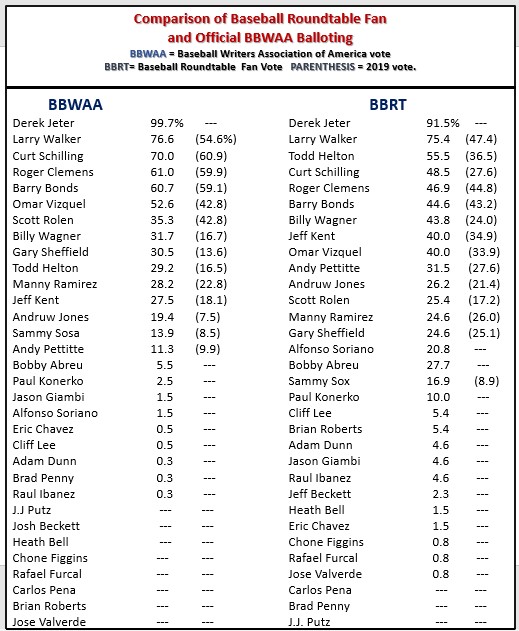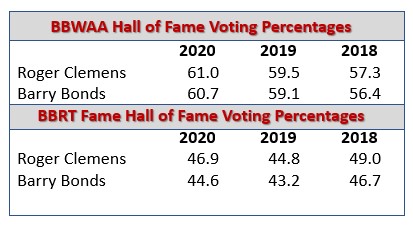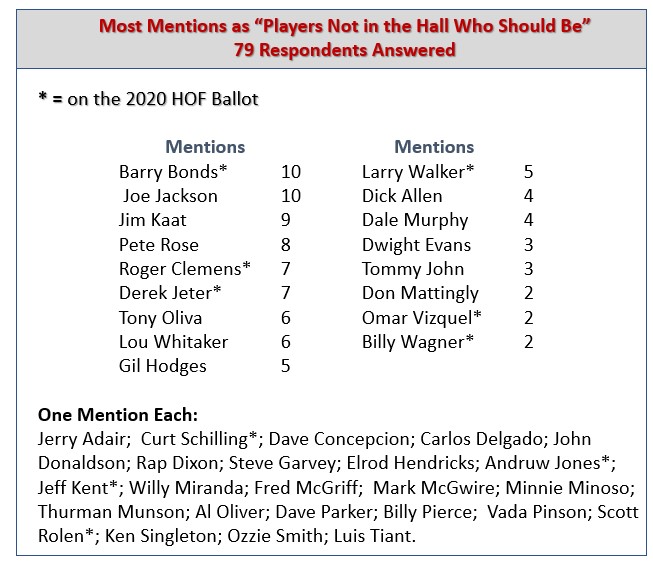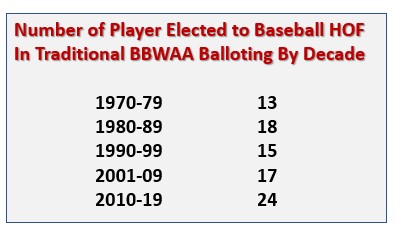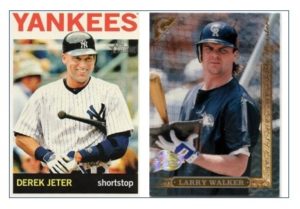 The official 2020 Baseball Writers Association of America (BBWAA) Hall of Fame balloting results are in (Or are they officially out?) and two players garnered the 75 percent supported needed for election – Derek Jeter (99.7 percent of the vote) and Larry Walker (76.6 percent). The same two players received at least 75 percent of the vote in Baseball Roundtable’s (BBRT) third annual (unofficial) fan ballot. This post will take a look at both the BBWAA and BBRT results – the similarities and the differences. At the end of the post, I’ll add some thoughts on voting patterns I have observed over the years.
The official 2020 Baseball Writers Association of America (BBWAA) Hall of Fame balloting results are in (Or are they officially out?) and two players garnered the 75 percent supported needed for election – Derek Jeter (99.7 percent of the vote) and Larry Walker (76.6 percent). The same two players received at least 75 percent of the vote in Baseball Roundtable’s (BBRT) third annual (unofficial) fan ballot. This post will take a look at both the BBWAA and BBRT results – the similarities and the differences. At the end of the post, I’ll add some thoughts on voting patterns I have observed over the years.
A total of 131 BBRT fan readers cast ballots – and the overall results mirrored the BBWAA results. The only two players garnering the necessary 75 percent in the fan vote were shoo-on, first-time-on-the ballot Derek Jeter (91.5 percent) and final-year-on the ballot Larry Walker (75.4 percent). Finishing third in the BBWAA voting was Curt Schilling, who got more support from the writers (70 percent) than the fans (who placed Schilling fourth at 48.5 percent).
Eight players finished in the top ten in both the BBWAA and BBRT balloting: Jeter, Walker, Schilling, Roger Clemens, Barry Bonds, Omar Vizquel, Billy Wagner and Todd Helton. Gary Sheffield and Scott Rolen rounded out the BBWAA top ten, while Jeff Kent and Andy Pettitte completed the BBRT top ten.
Side Note: When balloting first opened, BBRT predicted that, in the BBWAA balloting, Jeter and Walker would get in and Schilling would fall just a bit short. For that post, which included bios on all candidates and BBRT’s vote – if, of course, I had one – click here.
So, here’s the final tally, with some observations after the chart.
- The fans were a bit tougher on the prospect of a unanimous vote for Derek Jeter, giving him 91.5% versus the writers’ 99.7%. More on that later.
- Overall, the fans were a bit less demanding in their votes, with nine players getting 40% or higher, as compared to six at 40%+ in the writers’ balloting – and 12 players failing to get the 5% needed to stay on the ballot versus 17 dropping off the BBWAA ballot.
- The biggest gainer on the BBRT fan ballot was Larry Walker, who jumped 23 percentage points). Others moving up by at least 15 percentage points were: Curt Schilling (+20.9); Billy Wagner (+19.0); and Todd Helton (+19.0). Sammy Sosa’s vote total took the biggest drop among fans – declining 8 percentage points from one year ago. Walker was also the top gainer in the BBWAA balloting, up 22 percentage points. Others up at least 15 percentage points were: Scott Rolen (18.3); Gary Sheffield (16.9); and Billy Wagner (15.0).
- The fan ballot continued to show a stronger bias against those touched by the PED-controversey. Just a couple of examples:
- Todd Helton saw the most notable difference between BBWAA and BBRT Fan support – getting 55.5% of the fan vote (third highest) and just 29.2% of the BBWAA vote (tenth.)
- In addition to Todd Helton, those getting significantly more support from the fans than the writers were: Alfonso Soriano (20.8% in fan vote/1.5% in BBWAA vote); Andy Pettitte (31.5/11.3); and Jeff Kent (40.0/27.5).
- Those getting notably more support from the writers than the fans were: Omar Vizquel (52.6% from the BBWAA/40.0% in the BBRT fan ballot) and Scott Rolen (35.5/25.4).
—-FAN OPINION WHO’S NOT IN THAT SHOULD BE—-
Seventy-nine survey respondents answered the question regarding which players not currently in the Hall of Fame should be there. Overall, this group of respondents seemed to be a forgiving group – with the candidacy of three of the top four (in terms of mentions) bringing with them come controversy. Tied for the most mentions at ten (12.6% of those answering the question) were Barry Bonds (with his MLB single-season and career home run record, seven league MVP Awards and PED-controversy) and Joe Jackson (with a .356 career average and the 1919 Black Sox scandal). Also, in the top four, at fourth place with eight mentions, was all-time base hits leader Pete Rose (banned from baseball – gambling).
Sitting at number-three with nine mentions was southpaw pitcher Jim Kaat (with 283 victories and 16 Gold Gloves).
The top ten included: three players on this year’s ballot (two of whom were elected): Roger Clemens (seven mentions); Derek Jeter (seven); and Larry Walker (five). Also, in the top ten were Twins’ three-time batting champion Tony Oliva (six); Tigers’ 19-season 2B Lou Whitaker (six), the 1978 AL Rookie of the Year and a four-time Gold Glover; and Dodgers’ 1B Gil Hodges (five), an eight-time All Star and three-time Gold Glover.
A few interesting tidbits from these results. We also saw one mention each for:
- Rap Dixon, a Negro League star outfielder, who (according to the Seamheads.com Negro Leagues Data Base) hit .326 over 11 seasons and is also reported to have hit .372 in 26 games versus major leaguers.
- John Wesley Donaldson, a barnstorming African-American pitcher who, between 1911 and 1931, recorded a documented 406 wins and more than 5,000 strikeouts. You can learn more about Donaldson at johndonaldson.bravehost.com.
There was also one mention each for Ozzie Smith and Jack Morris, who are both already in the Hall of Fame and one for Charlie Brown (the losing-est pitcher in comic strip history).
The BBRT HOF Ballot Prize Pack went to Shawn H. of Washington – who will receive a 1990 Topps complete set; a Greg Maddux Donruss 1987 rookie card; a Joe Mauer bobblehead, commemorating his 2006 batting title; and a limited edition ball from the Tampa Bay “Devil Rays” inaugural game.
—–HALL OF FAME VOTING ‘CADRES” —–
Here’s a look at some Hall of Fame voting cadres, I have noticed over time. This, by the way, is not a judgement on voter strategies, but rather just an observation on factors that appear to have had a current or past influence on voting patterns and vote totals.
The Anti-PED Cadre
This group declines to vote for those who appear to be tied into the PED controversy. There continues to be enough of these voters to effectively block a significant number of PED-associated candidates from election. In recent years, this cadre has made its presence felt in both the BBWAA and BBRT balloting. There does seem to be a slowly diminishing effect among BBWAA voters, but the impact on BBRT fan ballot total has been relatively stable.
The Small Hall Cadre
This cadre has focused on demanding the highest standards for election to the Hall of Fame – and has voted vote for very few (sometimes even zero) candidates. This, by the way, is not a new approach. Back in 1988, for example, nine blank ballots were cast in the BBWAA voting. A Los Angeles Times article quoted New York Daily News reporter Phil Pepe (who sent in one of the nine blank ballots) as saying the Hall of Fame was “too crowded,” adding “I think to go in alongside Ruth, DiMaggio, Williams, Aaron, Cy Young, you have to be the cream of the cream. The more you erode the standards, the more the standards will be eroded.” This cadre has a notable impact on elections, since each ballot a player is not named on requires three ballots to counter that omission.
I should note that, in recent years, this particular voting strategy has been on the decline. In the past seven elections a total of 26 players have been elected in the traditional BBWAA balloting. That’s two more than were elected in the previous 14 years (2000-2013).
The Unanimously Adverse Cadre
This cadre has been made up of voters who are opposed to (or uniquely demanding) of a unanimous selection to the Hall of Fame. The more recent logic appears to have been “If Babe Ruth, Stan Musial, Willie Mays Cy Young or (insert a legendary player of your choice) was not a unanimous selection, why should player “X” be?” Mariano Rivera’s unanimous selection and Jeter’s close call seem to indicate this cadre’s days are behind us. Still, even when this is only a cadre of one, it is effective. I won’t speculate on this year’s lone ballot omitting first-timer Derek Jeter, but the fact that we’ve had only one unanimous selection in HOF voting history is a pretty good indicator that this cadre has impacted voting over time.
The Ballot-Hierarchy Cadre
Over the years, members of this cadre have drawn a line between first-ballot and subsequent-ballot votes.
The Ballot Hierarchy was a “thing” for a long time. In a 2013 column, ESPN’s Howard Bryant wrote: “I believe in the hierarchy of the ballot, that the first ballot is different than the second or the tenth, that there is a special prestige to a player being voted in the first time he is eligible.” The question for BBRT is, “Do voters just withhold that first-, second- or other-ballot vote, or does it go to another candidate who meets the hierarchy test?”
I should add that this can be a two-edged sword. While the ballot-hierarchy test may delay some players’ elections, it can also work in a player’s favor in the final years on the ballot – giving a particular boost in a player’s last year of eligibility. For example, Larry Walker’s final five years on the ballot saw his vote percentages go (in order) – 15.5, 21.9, 34.1, 54.5 and 76.6. His stats didn’t change over that time, but the clock on eligibility was ticking downward.
Side Note; There also appears to be a group of voters who combine “Ballot-Hierarchy” with “Anti-PED,” withholding votes from PED suspects until later years of eligibility. We’ll soon see how that plays out.
The Strategist Cadre
Somewhat related to the “Ballot Hierarchy” group – at least in impact – this group reasons that certain players are sure bets to get the required 75 percent and chooses not to add to the sure-thing margin, instead casting that vote for a player they find deserving further down the ballot. This approach may actually improve the chances of additional candidates. A subset of this group is those who note that certain players (in, for example, the 40 percent range), while NOT likely to reach 75 percent in a given year, ARE pretty much assured of adequate support to stay on the ballot. This subset withholds votes from those candidates and votes to protects those they would like to see on the ballot (but who are less “safe”).
The From-the-Heart Cadre
This group (which seemed to show up in the BBRT unofficial fan ballot more than in the BBWAA voting) casts votes for a specific player (or players) further “down the board” either as a “fan” statement or to ensure that player does not fall off the ballot (get less than five percent).
The Ten-Best Cadre
This group simply votes for whom they felt are the ten best players; regardless of the factors influencing any of the cadres already noted. (Well, in some cases it is the eight or nine candidates they feel are deserving.)
So, there’s BBRT’s look at the 2020 HOF election, as well as some observations of current and past voting strategies.
Primary Resources: Baseball-Reference.com; Baseball-Almanac.com; Blank Hall of Fame ballot serves as protest … January 14, 1988; Associated Press; Drawing a blank on a HOF ballot … January 9, 2013; Howard Bryant, ESPN Senior Writer; espn.com; My crowded Hall of Fame ballot, with no regard for the ‘sacred place’ … January 20, 2018; Ken Davidoff; New York Post (nypost.com); Hall of Fame Roundtable: Should voters ‘game” the ballot to get more players in? … January 22, 2018; Matt Snyder; cbssports.com; It’s a Hall voter’s prerogative to change mind … January 25, 2018; Patrick Reusse; StarTribune.
 Baseball Roundtable is on the Feedspot list of the Top 100 Baseball Blogs. To see the full list, click here.
Baseball Roundtable is on the Feedspot list of the Top 100 Baseball Blogs. To see the full list, click here.
I tweet baseball @DavidBBRT
Follow/Like Baseball Roundtable’s Facebook Page here. More baseball commentary; blog post notifications; PRIZES.
Member: Society for American Baseball Research (SABR); The Baseball Reliquary; The Negro Leagues Baseball Museum.
